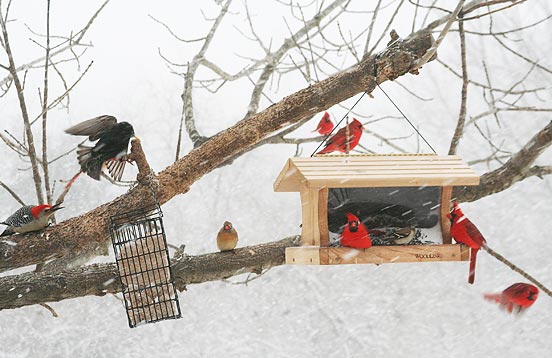Seeds and Shelter Through the Seasons
Birds choose environments that provide them with food, water, and shelter. If your backyard doesn’t provide these things, there are plants you can grow and many other ways you can enhance your yard to make it more bird-friendly. Here are some tips to help you:
First, take stock of what you already have. Draw a map of your property including buildings and other structures, sidewalks, fences, trees, shrubs, feeders, and nestboxes. Note sunny and shady areas, low or wet areas, sandy spots, and plants you want to keep.
Before you start digging holes and rearranging your yard, decide what plants you should add. Include plants from some of these seven important groups that are particularly valuable for birds :
A diversity of plants can provide birds with a diversity of food in the form of flower buds, fruit, seeds, nectar, sap, and a wide variety of the insects that associate with those plants. Plants also provide nest sites and nest material, and protected hiding places. The larger the variety of plants you grow, the more different kinds of birds your yard will attract.
Select locally-native plants appropriate for the lighting and soil conditions of your property. Consider how big a new plant might eventually grow, and avoid the surprise of it taking over your yard!
Plant locally native species. Plants native to your region and locality are more likely to thrive without pesticides or watering, plus they offer the foods best suited to the native birds of your area.
To keep the birds coming back for more, select a variety of plants that will produce foods in different seasons. For winter residents and migrants that return early in spring, plants that hold their fruits throughout the winter ("winter-persistent" plants) are a vital food source.
A dense thicket provides places where birds can nest, perch, and escape from predators. Plant shrubs, a hedge, or vines to trail up fence lines to create an area of thick, wild growth that imitates the natural environment.
Leave dead limbs and trees in place if it's safe and not too unsightly for neighborhood standards to do so. Insects that live in decaying wood are an important food source for birds such as woodpeckers, chickadees, and nuthatches. Cavity-nesting birds such as bluebirds and many woodpeckers need old, hollow trees to nest in. To make a dead tree prettier, consider planting native vines, such as Virginia creeper, to disguise its trunk.
Recycle dead branches to start a brush pile for your ground-dwelling birds, such as sparrows and towhees. It gives them hiding places and some protection from rain, snow, and wind. Start with thicker branches and put thinner ones over the top. Add your old Christmas tree if you have one.
If you don’t tidy up your yard and flowerbeds in fall, birds will love you for it. If you grow annuals, especially daisy-relatives such as purple coneflowers, black-eyed susans, and sunflowers, leave the dead seed heads on them when they fade—goldfinches, redpolls, and other seed-eaters will feast on the seeds. Instead of bagging up fallen leaves for disposal, rake them under your shrubs to act as mulch. They'll harbor insects that ground-dwelling birds will find, too. And, come spring, those dead leaves, grasses, and plant stems will be a treasure trove for birds searching for nest material in your yard.
First, take stock of what you already have. Draw a map of your property including buildings and other structures, sidewalks, fences, trees, shrubs, feeders, and nestboxes. Note sunny and shady areas, low or wet areas, sandy spots, and plants you want to keep.
Before you start digging holes and rearranging your yard, decide what plants you should add. Include plants from some of these seven important groups that are particularly valuable for birds :
Select locally-native plants appropriate for the lighting and soil conditions of your property. Consider how big a new plant might eventually grow, and avoid the surprise of it taking over your yard!
Plant locally native species. Plants native to your region and locality are more likely to thrive without pesticides or watering, plus they offer the foods best suited to the native birds of your area.
To keep the birds coming back for more, select a variety of plants that will produce foods in different seasons. For winter residents and migrants that return early in spring, plants that hold their fruits throughout the winter ("winter-persistent" plants) are a vital food source.
Leave dead limbs and trees in place if it's safe and not too unsightly for neighborhood standards to do so. Insects that live in decaying wood are an important food source for birds such as woodpeckers, chickadees, and nuthatches. Cavity-nesting birds such as bluebirds and many woodpeckers need old, hollow trees to nest in. To make a dead tree prettier, consider planting native vines, such as Virginia creeper, to disguise its trunk.
Recycle dead branches to start a brush pile for your ground-dwelling birds, such as sparrows and towhees. It gives them hiding places and some protection from rain, snow, and wind. Start with thicker branches and put thinner ones over the top. Add your old Christmas tree if you have one.
If you don’t tidy up your yard and flowerbeds in fall, birds will love you for it. If you grow annuals, especially daisy-relatives such as purple coneflowers, black-eyed susans, and sunflowers, leave the dead seed heads on them when they fade—goldfinches, redpolls, and other seed-eaters will feast on the seeds. Instead of bagging up fallen leaves for disposal, rake them under your shrubs to act as mulch. They'll harbor insects that ground-dwelling birds will find, too. And, come spring, those dead leaves, grasses, and plant stems will be a treasure trove for birds searching for nest material in your yard.


 Del.icio.us
Del.icio.us Digg This!
Digg This!  Facebook
Facebook Newsvine
Newsvine Yahoo!
Yahoo! StumbleUpon
StumbleUpon
No comments:
Post a Comment